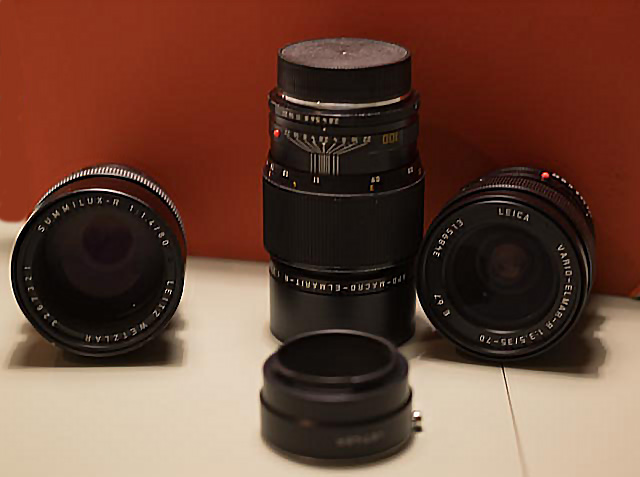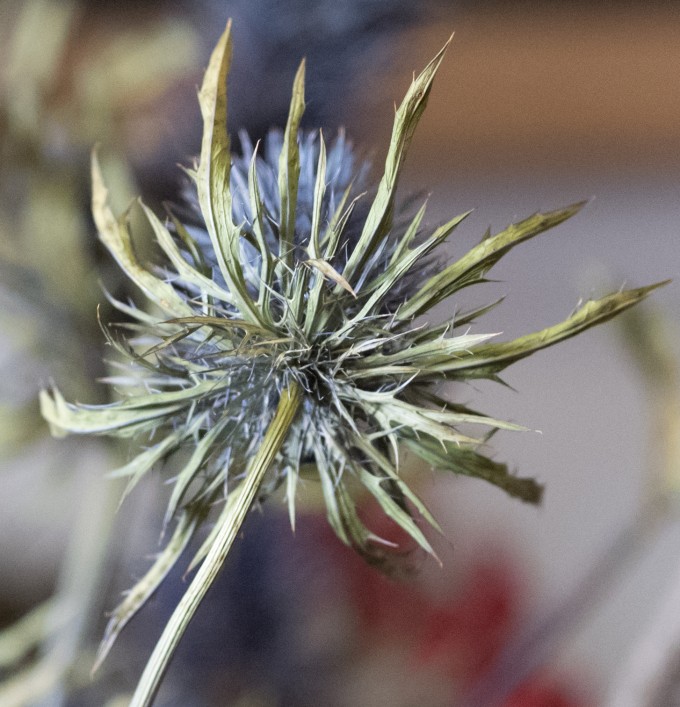Old and new :Leica M vs Leica R Lens comparison on the SL
by Jean-Marc Bottazzi
Hi Steve, love your site.
Here what I was thinking with the SL being more SLR like in the leica world I got interested to look a bit at R glass on the SL and do some not so serious comparisons. Those lenses also are a popular choices for duclos cinemod. That is way cheaper than the new leica cine offering (which I am sure is better but well…). Anyway I bought the novoflex R adapter since I cannot find the leica one yet and bought a few old R lenses and decided to compare a bit with the 50 apo and the new vario elmar I own. I shot the same scene from the same spot with all lenses with the intention to compare crops.
I bought:
-the 80mm summilux R f1.4
-the apo macro emarit 100mm f2.8
-the old vario elmarit 35-70mm f3.5
The scene is the following:
I used a lightbox making sure the speed is always at least 1/250s. I focused on the same flower in the shaded rectangle and here are the crops of that flower.
First two pictures are the 50 apo at f2 and f4 respectively… great as expected.
Next come 3 pictures with the 80mm summilux R @f1.4 2.8 and 4 respectively. A bit soft by comparison … if you step down to f4 the summilux gets sharper but there is room for more sharpness. At f1.4 you can get as much isolation of subject as the 50 APO at f2 but you pay with less sharpness on your subject. If you step down you lose isolation as more of the picture gets sharp and busy. The 80 summilux R overall is no match for the 50 APO.
The next two pictures are taken with the elmarit apo macro 100mm at f2.8 and f4 respectively. Now that is sharp! Especially at f4, but so should it be, it is a macro lens after all and a good one at that. But note that the 50mm apo is keeping up quite even when scaling up. In spite of the different focal length the APO manages to isolate its subject with micro contrast highest sharply around focus plane only — in other words the picture is less busy more on its subject — for the macro and the 50 apo more than the other lenses in this batch we have this nice combination of incredible sharpness in focus combined with strong isolation ability.
Next something very interesting : the new vario elmar 24-90 @50/f4 80/f4 and 90/f4 respectively now that is sharp as well at all focal lengths. Zoom will have more depth of field than the primes previously introduced but the new zoom looks extremely sharp.
Finally the last two picts are the old vario elmar R at 50mm/f4 and 70/mm f4. Not too bad especially given that the old vario elmar is much more compact than the new one. It makes it an interesting lens for travel in my opinion even without autofocus it almost keeps up with the new vario elmar in terms of sharpness. Now at same aperture it looks to me that the new vario elmar is better at being sharp only around the focal plane only (while the old vario elmar is more zero to infinity sharpness). This shows when you compare the 2 shots 70mm f4 between old and new vario elmar. Of course prime are more isolating that the zooms but the new vario elmar is showing an interesting behavior especially compared with its ancestor.
Again this is not meant to be serious but it helps me having a bit of intuition on how to compare those lenses.



















Yes 100 APO elmarit 2.8 — this one: http://www.overgaard.dk/Leica-100mm-APO-Macro-Elmarit-R-f-28.html . Feels going to be a true treasure. (see also http://slrlensreview.com/web/reviews/leica-lenses/leica-macro/418-leica-apo-macro-elmarit-r-100mm-f28-leica-apo-macro-elmarit-r-100mm-f28-e60-lens-review)
Browsing further there is an old article by David Putt comparing 80 1.4 R summilux, the 100 2.8 APO macro elmarit and the 90mm APO summicron R (I imagine close to the M version see http://www.l-camera-forum.com/topic/252230-r-vs-m-90mm-apo-summicron/) :
http://www.overgaard.dk/pdf/Puts_Column_80-100_mm_Leica_R_Lenses_en.pdf
Did you mean 105mm APO Elmarit Macro – R lens ?
Yes 100 APO elmarit 2.8 — this one: http://www.overgaard.dk/Leica-100mm-APO-Macro-Elmarit-R-f-28.html . Feels going to be a true treasure. (see also http://slrlensreview.com/web/reviews/leica-lenses/leica-macro/418-leica-apo-macro-elmarit-r-100mm-f28-leica-apo-macro-elmarit-r-100mm-f28-e60-lens-review)
Browsing further there is an old article by David Putt comparing 80 1.4 R summilux, the 100 2.8 APO macro elmarit and the 90mm APO summicron R (I imagine close to the M version see http://www.l-camera-forum.com/topic/252230-r-vs-m-90mm-apo-summicron/) :
http://www.overgaard.dk/pdf/Puts_Column_80-100_mm_Leica_R_Lenses_en.pdf
Oh, God just shoot me now please before I see another bunch of these mind numbing lens tests. If there were any real relationship between sharpness and good photographs perhaps there’d be some justification for this visual drivel, but there isn’t.
But yet you are here reading the post and commenting – if you do not want to see lens tests, then you always have the option of NOT clicking on the post or reading it. Just ignore it until the next post that catches your eye. Thats the beauty of a blog. You do not have to read all posts 😉
You lucky one. The camera felt incredibly nice in my hand at a first try. I remeber an ultrasexy quiet “dry” shutter sound and the first non slr viewfinder that let me hope of being able to focus without loosing the compostion.
Its all invisible in the product images or even on a shelf right in front of you. Its only experienceable.
I was struck by its toolishness – in this respect it seams to be a one hundred percent match to the R-system. Beauty out of its use, or more precise its utility design qualities. That is much more Ulm Design school rather than Bauhaus – despite its very few and simple radiuses – I think Dieter Rams and Otl Aicher would have been more pleased by this conceptually rooted design work than by the attempt of moving Leicas dot into the middle of the M240.
Don’t get me wrong Mr. de Silva – I wouldn’t want to move the alfa, audi or vw logos off center.
Back to subject – the R lenses appear to be matching in size perfectly and therefore maybe even better than their M or SL counterparts.
Irony of fate – the R-lenses are a better match technically too, as their retrofocus design keeps the rear lens element, respectivly the exit pupil away from the sensor.
And they have much closer minimum focus distances.
Even the 19mm ultra wide Rs do not show any italian flag. And it is by far not – that only the latest R-Designs can surpass the resolution of todays sensors.
Just try a first generation Elmarit-R 2,8/90mm from the early sixties. I prefere it wide open by its bokeh and sharpness balance to the 90ApoAsph R wide open – not to speak of its M-counterpart with the very limiting one meter minium focus distance.
Happy Days for you Mr Sehstedt.
It looks to me like the focus of the 80mm is on the back part of the flower– and the front part of the flower may only be soft due to focus– and not lens sharpness? Especially in the 2nd two 80mm pictures…
I agree. Totally, Peter.
And:
It is a crop only.
We dont’t know whether the distance to the subject or the frame was kept constant – befor cropping.
It is not exactly the subject a portrait lens is made for.
et cetera.
BUT:
I’m still very happy seeing someone making this effort with R-glas. I’m very pleased and enjoy looking at what we have – Thank you VERY MUCH Mr. Bottazzi !
The maximum benefit of any lens review would give us a clue of what a certain lens is espaecially good at. I’m personally less interested in what it is bad at.
In my experience it takes years of use under different circumstances and on different tasks and situations and side by side with other gear to get a reliable idea and it still remains a little bit personal.
In their Lens overview catalogues Leica used to show just one image per lens, that had to represent maybe the best each lens could give or a significant strength of each lens. I find this more useful than itappears in the first place. Although some lenses – like the 80 Lux definitely have more than one strength.
But despite all this you can still have a lot of fun by looking at the images above.
To both of you. Yes this is a quick thing and not meant to be serious — a lot of imperfections — first I shot everything from same distance. This makes long lenses look better (and the 50 APO is even more impressive considering) and yes those are just crops
For the sharpness of the lens you look at the place of maximum sharpness wherever that is — if found that some leaves around the flower of the thistle where in focus in all pictures — and I try to look at how detailed their texture is across pictures (I stress ‘try’). Lab tests on the 80 summilux R confirm a distinct difference even at the center between sharpness at f1.4 and f4.
Even if the summilux 80 wide open is not as sharp at maximum sharpness as the macro elmar,the 50 apo or even the zoom, it is still a great. Moreover to me the lens is still most interesting wide open. Bear with me and think of lenses like mountaineering climbs (yes that is a bit odd I guess). You do not judge them uniquely by the altitude you reach (the sharpness) but also on how much fun and difficult the climb is, how steep it is (how isolating is the lens). You care because this determines your ability to inject intention in the picture by making your subject pop.
From this perspective the 80 is actually the best of the bunch in its focal length. It is a great climb and does not matter that it does not reach the altitude of sharpness of others… as it can make the subject jump at you in a way that the zooms just cannot.
That being said both the 50 and the 100 APO have just everything… steepness of approach and altitude
Jean-Marc
A big: YES.
For me lenses are like brushes. They have to have a distinct quality to make me use them.
Versatility is a plus. And stopdownsharpness is not the exception among Leica-R Portrait lenses.
Underrated pricing is something for the hunting instincts ? – or can be a simple availibility condition.
If you are – lets say working as a full time artist with photography, I mean that type who does no assignments and is not yet at gagosians or goodmans – you might be very happy to know there are some serious tools available for you.
Thanks to the work of Steve, Brandon and Jean-Marc Bottazzi those kind of crazy people get a chance of knowing about it and the rest gets at least VERY entertaining and charming information.
Nice to know, all my six R-lenses will produce good image quality on a SL. Now I’ve just to order the new Leica SL.
Thanks for sharing!
Lift off – of a huge range of phantatsic glas.
The subject you choose is pleasing and I would not have thought, that the old zoom would do that well.
Maybe part of what appears as low sharpness of the 80 Lux wide open, is also owed to the shallow depth of field – wich should be much smaller due to focal length and the faster apperture compared to the 50 Apo – independent of the quality of the lens design, just because of physics.
I use the 80 Lux side by side with the more modern 90 R Apo-Asph, the 100 Apo Macro and the other R 90’s and modern M glas for several years now and can state that it appears to me the most special lens among the Leica portrait R Lenses.
It is very versatile, since it is sharp into the corners stopped down and has a distortion even below the APO 50 M.
Besides that it has a creamy but unique and disreet bokeh wide open. It stays just on the right side of the borderline to what the viewer will percieve as an effect.
And it could be underrated because of just that.
Yes I agree with you on the 80 (see my comment above) — max sharpness is not the only game in town. For the 80 it is lower than the others — you can see it by staying in the plane of max sharpness, and it shows in tests, but isolation is impressive.
I’m happy to agree.
I find the unsharpness rendering of the 80 Lux wide open very,very pleasing on this ocasion. How it renders the star-like-shaped violet flower in the background or how the reds are melting in the bokeh is just outstanding – campared to any other image shown ?
It’s always difficult to draw firm conclusions from reduced sized/compressed shots from others on screen, but I’m pleased that the 100mm Macro shows so well, and rather surprised that the 80mm f1.4 less so.
I’ve used a number of M and R lenses on a Monochrome and now on an A7Rii – a camera definitely capable of showing a lens’ capability – 50mm Noctilux f0.95, 50mm f2 Summicron, 90mm Apo Summicron-M f2.0, 35-70mm-R f3.5 and f4 versions, 100mm f4 Macro and 100mm f2.8 macro.
The zooms are both good lenses for the price, but the f4 definitely seems to have the edge and now ives on my Sony. I’ve been lucky enough to find a mint 100mm f2.8 to replace my f4. Its reputation is outstanding and I can see why. Whilst cameras are still limited to c.40 mpx if any lens ever gets sharper (especially wide open, for the isolation) then I think it would be of marginal benefit, it is astonishing, so if the 50mm ‘keeps up’ it must be brilliant! Having said that, the f4 version is great too and loses little to my eyes (even on the 43 mp Sony) other than the aperture limit, and is such a bargain these days it could be a great buy for SL users.
The 90mm Apo Summicron, which I found more useful for my kind of photography than the 50mm lenses, makes me want to cry… because I had to sell it, along with the Noctilux.
Yes I was also surprised by the 80mm maximum sharpness does not keep up, but isolation (how this sharpness quickly falls off is great at 1.4) is impressive– this is consistent with some older reviews : http://slrlensreview.com/web/reviews/leica-lenses/leica-telephoto/419-leica-summilux-r-80mm-f14-e67-lens-review. Basically 2 things are desirable : that maximum sharpness is high, but also that the lense has a capacity to keep this sharpness concentrated around your subject only — on this count the 80 still does great IMO.
A few of the lens you mentioned already have caught my interest I will later try the at least 90APO and the 2 nocts to the same test.
Finally we have lift of – well, at least of the R-glas into wider consciousness.
…. caused by the launch of the SL. That toook a while, but – Yipeee. the return of the R.